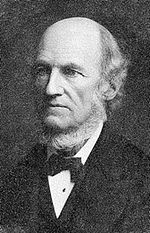Ideomotor Effect
Researched and Written
By
Allen Tiller

William Carpenter
Carpenter's research documents indicate that muscular movement can be achieved by the human brain unconsciously, thus initiating movement unknowingly to the holder of a pendulum or other paranormal “seeing” device.
Carpenter identified the Ideomotor Effect as a third category of non-conscious behaviour, with excitomotor (breathing) and sensorimotor (being startled) effects being the first and second categories. He theorised that hypnotic suggestion, applied kinesiology and the movement of pointers on an Ouija Board are all applied due to the Ideomotor effect.
Ideomotor effects occur without the conscious choice of any person, they are subtle, often unnoticeable movements that draw from a person's emotions - an example of this would be tears forming in the eye when one is happy or sad, a totally unconscious effect of the human existence.
The effect has been researched and continually expanded on over the years since Carpenters' discovery.
American Psychologist Ray Hyman writes in 1977, “Honest, intelligent people can unconsciously engage in muscular activity that is constant with their expectations”. They also show that suggestions that can guide behaviour can be given by subtle clues by onlookers and those involved in seances or Ouija board sessions.
So how does this apply to the paranormal?
As we have seen above with our preconceived notions, our minds manipulate our muscles and lead our pendulum or Ouija board planchette to answers we already expect, whether good or bad, This would suggest that nothing paranormal is happening in our dowsing experiments/ sessions, but is this definitive proof that the Ideomotor effect is the cause, some researchers don't believe so and experiments are being done to prove otherwise.
In recent experiments, a gentleman from “project reveal” attached his Pendulum to a Vander-Graff to prove that static electricity can move a pendulum.
Watch his video here:
Moving a Pendulum using Magnetic Fields
This one we are going to leave open for you, Constant Reader, to decide what you believe, visit us in our forums here on the Eidolon Paranormal website to discuss this phenomenon further and your beliefs as to whether it is indeed paranormal, or actually a natural phenomenon!


No comments:
Post a Comment